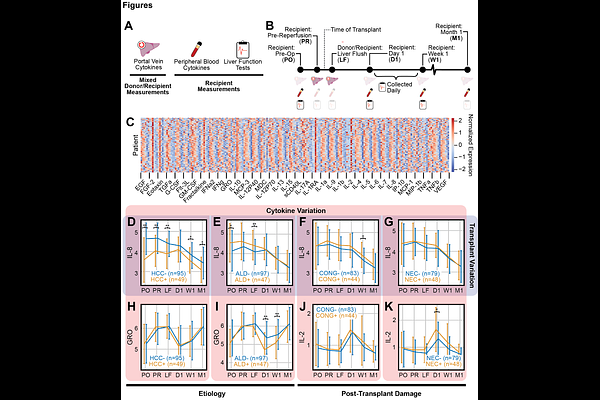Tensor-Based Integration of Time-Series Measurements Reveals Relationships Between Underlying Disease, Early Injury, and CD4+ Polarization in Liver Transplantation

Tensor-Based Integration of Time-Series Measurements Reveals Relationships Between Underlying Disease, Early Injury, and CD4+ Polarization in Liver Transplantation
Chin, J. L.; Tan, Z. C.; Sosa, R. A.; Zheng, Y.; Gjertson, D. W.; Hoffman, A.; Kaldas, F. M.; Zhai, Y.; Kupiec-Weglinski, J. W.; Reed, E. F.; Meyer, A. S.
AbstractFor patients with end-stage liver failure, liver transplantation (LT) remains the standard-of-care, though five-year allograft survival rates remain below 80%. Liver ischemia reperfusion injuries (LIRI) arise during transplant and contribute to allograft dysfunction. While many drivers of LIRI have been well-characterized, the relationships between LIRI and later immunological signatures remain poorly understood, possibly because of limited integrated studies examining immunological signatures across the LT process. Furthermore, the role of underlying disease in LT remains poorly understood as it is unknown if later immunological signatures are universal or etiology dependent. To better examine etiology- and LIRI-driven immunological mechanisms across the LT lifetime, we collected cytokine and liver function test (LFT) measurements from LT donors and recipients at multiple pre- and post-operative timepoints. By developing a tensor-based factorization method to integrate these longitudinal measurements, we reduced the datasets to four immunological signatures that manifested across cytokines, LFTs, and time. Correlative analyses revealed associations between these integrated immunological signatures with etiology and LIRI. Later integration of allograft survival into this factorization method reduced these four signatures to two that were predictive of five-year allograft survival. Examination of these signatures prognostic of allograft survival found that CD4+ hyperpolarization towards Th1 or Th2 subtypes impaired growth factor expression and led to increased allograft loss risk. Clinical correlates revealed that donor and recipient age alongside etiology and donor liver health modulate this balance of CD4+ polarization in LT. Collectively, these results link immunological mechanisms to etiology and LIRI offering immediately actionable clinical insights alongside etiology- and donor-specific therapeutic targets for improving LT outcomes.